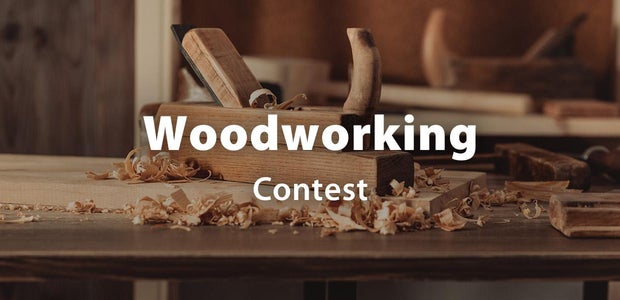Introduction: Circuit Building 101
This is a beginner's guide to building circuits that will talk about the "proper" way to install components (resistors, ICs, capacitors, etc), and also a little bit about soldering. It'll cover things like recommended tools, how far and which direction components should be inserted, pre-bending and clinching leads along with some tips and tricks. We'll be using a power supply kit made by David at uCHobby.com that plugs into a bread board for demonstration. Yep, we're commercial and sell all this stuff, but the advice should apply equally well to anyone's tools and circuits.
Step 1: Recommended Tools and Supplies
- Soldering iron and solder: Just about any 25-30 Watt soldering iron will do. Ideally, the temperature of you iron would be between 600-700 degrees F (for lead-free solder, 700-800 is recommended). How temperature relates to wattage depends a lot on the iron (watch a video testing the temperature of cheap RadioShack irons), and some high wattage irons have too high of a temperature. Avoid "solder guns" as these are meant for pipe soldering. Not only can these be too hot, but they work by running high current through a resistive heating element, and this could apply dangerous voltages to your circuit.
For solder, we recommend starting out with a lead-based solder, usually called 63/37 (63% tin, 37% lead by weight) or 60/40 rosin cored solder. Get whatever's cheaper; there's unnoticeable difference in hand soldering between 63/37 and 60/40. The rosin is a flux that cleans parts so solder will bond with them. Avoid solid wire (no flux core) and acid cored solder (for plumbing, too aggressive for circuits). We recommend solder that's about .031" in diameter for most through-hole components. Water-soluble flux is much more aggressive than rosin, and these residues must be cleaned. Lead-free solder melts at a higher temperature, and doesn't wet or spread out as readily, so it will be slightly harder to use.
- Needle Nose Pliers: Useful for pre-bending leads, pulling out components during de-soldering, and a lot of other things.
- Wire Strippers: Two types are shown: the yellow ones can be adjusted to strip any size wire (good for small 28-30 AWG ribbon cable wires) whereas the red handled ones have several fixed hole sizes.
- Flush Cutters: Used to trim leads close to the board after soldering .
- Clamps: Oftentimes just resting your board on a table will be fine, but the clamps are especially helpful when desoldering parts or soldering wires together.
- Solder Sucker and Solder Wick: Both are inexpensive ways to remove solder. The sucker is a spring loaded tube that vacuums out solder and the wick is a fine braid of flux coated copper that soaks up solder.
- Multimeter: Some multimeters have a continuity check that beeps if there is a complete circuit. This is very useful for making sure parts are connected or disconnected when there're a lot of wires and parts.
-Pink Erasor: (not shown) A pink eraser can be used to rub off oxides from older components and boards without risking damage to the parts.
For solder, we recommend starting out with a lead-based solder, usually called 63/37 (63% tin, 37% lead by weight) or 60/40 rosin cored solder. Get whatever's cheaper; there's unnoticeable difference in hand soldering between 63/37 and 60/40. The rosin is a flux that cleans parts so solder will bond with them. Avoid solid wire (no flux core) and acid cored solder (for plumbing, too aggressive for circuits). We recommend solder that's about .031" in diameter for most through-hole components. Water-soluble flux is much more aggressive than rosin, and these residues must be cleaned. Lead-free solder melts at a higher temperature, and doesn't wet or spread out as readily, so it will be slightly harder to use.
- Needle Nose Pliers: Useful for pre-bending leads, pulling out components during de-soldering, and a lot of other things.
- Wire Strippers: Two types are shown: the yellow ones can be adjusted to strip any size wire (good for small 28-30 AWG ribbon cable wires) whereas the red handled ones have several fixed hole sizes.
- Flush Cutters: Used to trim leads close to the board after soldering .
- Clamps: Oftentimes just resting your board on a table will be fine, but the clamps are especially helpful when desoldering parts or soldering wires together.
- Solder Sucker and Solder Wick: Both are inexpensive ways to remove solder. The sucker is a spring loaded tube that vacuums out solder and the wick is a fine braid of flux coated copper that soaks up solder.
- Multimeter: Some multimeters have a continuity check that beeps if there is a complete circuit. This is very useful for making sure parts are connected or disconnected when there're a lot of wires and parts.
-Pink Erasor: (not shown) A pink eraser can be used to rub off oxides from older components and boards without risking damage to the parts.
Step 2: What Order and Which Way to Insert Components
Most people advise to start with the shorter components first, and add more by height from there. This has two benefits:
- If there are tall components right next to shorter ones, you avoid having to bend already-installed taller components out of the way while inserting shorter ones later on.
- One of the best ways to hold a component in place is to insert it, and then lay the board upside down so the table surface keeps the component in place. If you install shortest to tallest, the tallest component will always be the one you're currently working on.
It's also helpful to install components so that the value can be read in the same direction as the surrounding text. For instance, install all the resistors with their tolerance bands on the right so that all the values can be read without having to rotate the board.
Make sure the notch on ICs matches the notch on the board.
- If there are tall components right next to shorter ones, you avoid having to bend already-installed taller components out of the way while inserting shorter ones later on.
- One of the best ways to hold a component in place is to insert it, and then lay the board upside down so the table surface keeps the component in place. If you install shortest to tallest, the tallest component will always be the one you're currently working on.
It's also helpful to install components so that the value can be read in the same direction as the surrounding text. For instance, install all the resistors with their tolerance bands on the right so that all the values can be read without having to rotate the board.
Make sure the notch on ICs matches the notch on the board.
Step 3: Prebend Leads for Easy Insertion
To avoid stressing the holes and junction between the resistor body and its lead, pre-bend the leads before inserting the part. To do this, line up the resistor on it's board location, grip the lead a little inside with needle nose pliers and then fold the lead over the pliers. The pliers prevent stress from reaching the the connection point between body and lead. You can also use something called a christmas tree to quickly form both leads to the correct size.
Just fyi, for sensitive circuits (ie, military, space), serrated pliers aren't allowed because they might create a divot in the lead that could weaken and fail from vibration.
The "right" way aside, just bending the leads with fingers can work well, too
Just fyi, for sensitive circuits (ie, military, space), serrated pliers aren't allowed because they might create a divot in the lead that could weaken and fail from vibration.
The "right" way aside, just bending the leads with fingers can work well, too
Step 4: Clinch Leads to Hold Parts in Place While Soldering
Clinching means bending the lead slightly on the other side of the board to hold the part in place. For ICs, bend two opposite corners outwards.
The only downside is that parts can be harder to remove later. Other methods to hold things in place while you flip the board over include just having the table surface hold it in place, and also using tape. For instance, header pins can't be bent, so the table is used to hold them up in the last picture. You can also place some solder on one empty pad, and then reheat that pad while pressing the part through to get started.
In industrial manufacturing processes, parts are either held in place by a small drop of adhesive (for surface mount) or by clinching the leads. Boards are then transported via conveyor over molten fountains of solder (google wave soldering).
The only downside is that parts can be harder to remove later. Other methods to hold things in place while you flip the board over include just having the table surface hold it in place, and also using tape. For instance, header pins can't be bent, so the table is used to hold them up in the last picture. You can also place some solder on one empty pad, and then reheat that pad while pressing the part through to get started.
In industrial manufacturing processes, parts are either held in place by a small drop of adhesive (for surface mount) or by clinching the leads. Boards are then transported via conveyor over molten fountains of solder (google wave soldering).
Step 5: Make Sure LEDs and Some Capacitors Are Inserted in the Right Direction
The longer lead on electrolytic capacitors (the cylinder ones) and LEDs is positive. Insert most components until they lie flat on the board for extra stability unless they have a metal casing that could cause a short circuit.
it's OK if the yellow plastic on ceramic capacitors (disc shaped) goes beneath the top level of the board and touches the solder, it just can't show through to the other side (according to IPC, the industry's soldering standards organization).
it's OK if the yellow plastic on ceramic capacitors (disc shaped) goes beneath the top level of the board and touches the solder, it just can't show through to the other side (according to IPC, the industry's soldering standards organization).
Step 6: Soldering
You've probably heard that solder should melted on the parts and not the iron tip. The catch is that a dry tip will not transfer heat very well. You need to have a little solder, called a heat bridge, between the iron tip and parts. Do this by either melting a small amount of solder on the tip before soldering ("tinning" the tip) or adding some solder at the junction between tip and work. Then melt solder on the opposite. It should spread out towards the iron tip and heat. A video is available with many more details.
Usually people say that joints should come out looking shiny, but this is only true for lead-based solder. Lead-free joints will have a duller surface finish, but still be perfectly fine joints. With either type, the solder should cling to or wet the surfaces, and not just sit on top of them. It should form a smooth ramp and feather out across the pad. The above link also has some galleries of good and bad joints.
It's a good idea to check the part for correct alignment after soldering one pin. Adjustments can easily be made at this point by reheating that one pin, but once multiple pins have been soldering, the part may need to be completely removed to adjust it.
Usually people say that joints should come out looking shiny, but this is only true for lead-based solder. Lead-free joints will have a duller surface finish, but still be perfectly fine joints. With either type, the solder should cling to or wet the surfaces, and not just sit on top of them. It should form a smooth ramp and feather out across the pad. The above link also has some galleries of good and bad joints.
It's a good idea to check the part for correct alignment after soldering one pin. Adjustments can easily be made at this point by reheating that one pin, but once multiple pins have been soldering, the part may need to be completely removed to adjust it.
Step 7: Trim the Leads
Flush cutters are useful for trimming leads close to the surface. Regular diagonal cutters can work, also. Safety goggles are actually a good idea for this step as the leads can fly off quickly. We usually like to hold on to the lead while clipping.











